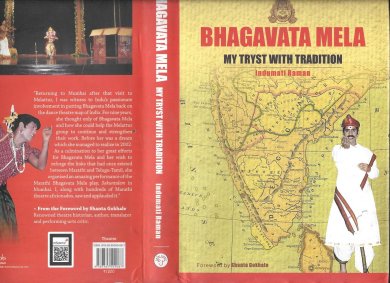
|   |

|   |
 The ritual dance of devotion from Melattur The ritual dance of devotion from Melattur- Dr. Utpal K Banerjee e-mail: ukb7@rediffmail.com August 3, 2018 Bhagavata Mela: My Tryst with Tradition By Indumati Raman Indus Source Books, Mumbai, 2018 ISBN: 978-93-85509-08-7, Price 1200 As graphically described by the author at the outset, deep in the interior of Thanjavur district lies a small village, Melattur, redolent with traditions of rituals, dance, music and theatre. The male Brahmin priests of the local temple of Sri Varadaraja Perumal perform classical dance of Bhagavata Mela to pure Carnatic music, enacting various divine stories of Vishnu. The dance's unique feature is that all artistes are male, including the dancers for female roles, keeping alive a 500-year-old heritage carried across generations. (Incidentally, the author adduces an interesting reason as to why male actors dominated the performing arts tradition worldwide. According to her, the underlying reason is 'pollution' - called 'tittu' in Tamil and 'kegare' in Japanese. Interestingly, even today in south India - and in Japan's Noh and Sumo traditions - the belief, howsoever mistaken, is that women are unclean by their bodily functions related to their biological roles as mothers. According to this belief, women having their regular 'periods' are polluted that can be contaminating and anyone associated even with a recent childbirth must undergo purification ceremonies after the 'period' is over.) In scanning the history and evolution of the Bhagavata Mela tradition, the author traces the lineage of the scholarly Nayaks and the Maratha kings of Thanjavur who honored the artists who penned Bhagavata Mela natakams in Telugu, Sanskrit and Marathi. For instance, Melattur Venkatarama Sastri wrote as many as twelve plays in the Telugu language. Narasimha, the fourth incarnation of Vishnu, holds special significance to these Brahmin Bhagavatars. Every year on Narasimha Jayanti - which falls in the months of April/May - the local population of Melattur gathers at the above temple and celebrates the festival with a performance of Prahlada Charitam, the story of the manifestation of the incarnation. Since the story of Narasimha is central to Bhagavata Mela tradition, a mask is used to portray the awe inspiring form of this incarnation. In the Melattur temple, in particular, a 300-year-old mask of Narasimha is worshipped round the year. On the Narasimha Jayanti day, this mask is taken out and worn by the actor who is privileged to play the role of Narasimha. Again, there is a belief that the mask is energized by prayers and worship in the temple and this spiritual power is passed on to the actor who portrays Narasimha at the annual festival. (A mask for the elephant god Ganapati is also used, but is not conferred the same status.) One interesting feature of the book is an overview it offers for Sanskrit drama, its decline and the rise of regional drama, with reference to Bhagavata Mela. Bharata's Natya Shastra was the fountainhead for performing arts like dance and music, and laid the foundation of Sanskrit drama. While a Sanskrit drama was embellished by layers of complexity lending it a sophisticated veneer, one of its drawbacks was its emphasis on poetic elements, where the dramatic element of the story became submerged in richly embroidered lyrics and dialogue. Sanskrit theatre reached its glorious peak in the first ten centuries, beginning from Asvaghosha, a Buddhist playwright; Bhasa (4th to 5th century) whose thirteen plays have survived the ravages of time; Shudraka, credited with one of the all-time most popular plays Mricchakatikam (The little Clay Cart); Kalidasa, one of the nine gems (or scholars) who adorned the royal court of Chandragupta II of the Gupta period (320-550 AD), whose celebrated works reflect his artistic skill as a poet and playwright of nature, love and emotions, as best remembered for Abhijnana Sakuntalam; and Bhavabhuti, best known for Uttara Rama Charita around 700 AD. After the 10th century, Sanskrit works did not come up to the gold standards held up by these five poets, namely, Asvaghosha, Bhasa, Shudraka, Kalidasa and Bhavabhuti. Gradually, Sanskrit drama receded from the literary scene. The author recounts that in Oberammergau, Germany, the Passion of Christ is enacted where the entire village participates. In 1633, when the village was threatened by the bubonic plague, the villagers vowed that if they were spared from the epidemic, they would stage the drama of the last days of Christ. This tradition is being continued till today and the play is performed in specific years. A very similar belief exists in Bhagavata Mela where parents of children in need of special prayers - during sickness or ill health - take a vow to make the child don the role of Ganapati during a Bhagavata Mela performance. The book also describes the privileged journey of the author who, with the cooperation of the Melattur artistes, helped to focus the limelight on Bhagavata Mela. In 2002, Babasaheb Ekoji II's natakam Shakuntala was produced, directed and staged in Mumbai by the author in collaboration with artistes from both Melattur and Mumbai. The effort received acclaim and appreciation from the Marathi theatre fraternity in Mumbai. Parts Two and Three of the book delineate this journey in great details. On the whole, the book is unmistakably a fruit of author's passionate love for this traditional art and can certainly be recommended to the art lovers of the land.  Dr. Utpal K Banerjee is a scholar-commentator on performing arts over last four decades. He has authored 23 books on Indian art and culture, and 10 on Tagore studies. He served IGNCA as National Project Director, was a Tagore Research Scholar and is recipient of Padma Shri. Post your comment Unless you wish to remain anonymous, please provide your name and email id when you use the Anonymous profile in the blog to post a comment. All appropriate comments posted in the blog will also be featured in the site. |